headlight Alfa Romeo Giulietta 2011 Owner handbook (in English)
[x] Cancel search | Manufacturer: ALFA ROMEO, Model Year: 2011, Model line: Giulietta, Model: Alfa Romeo Giulietta 2011Pages: 297, PDF Size: 9.37 MB
Page 210 of 297
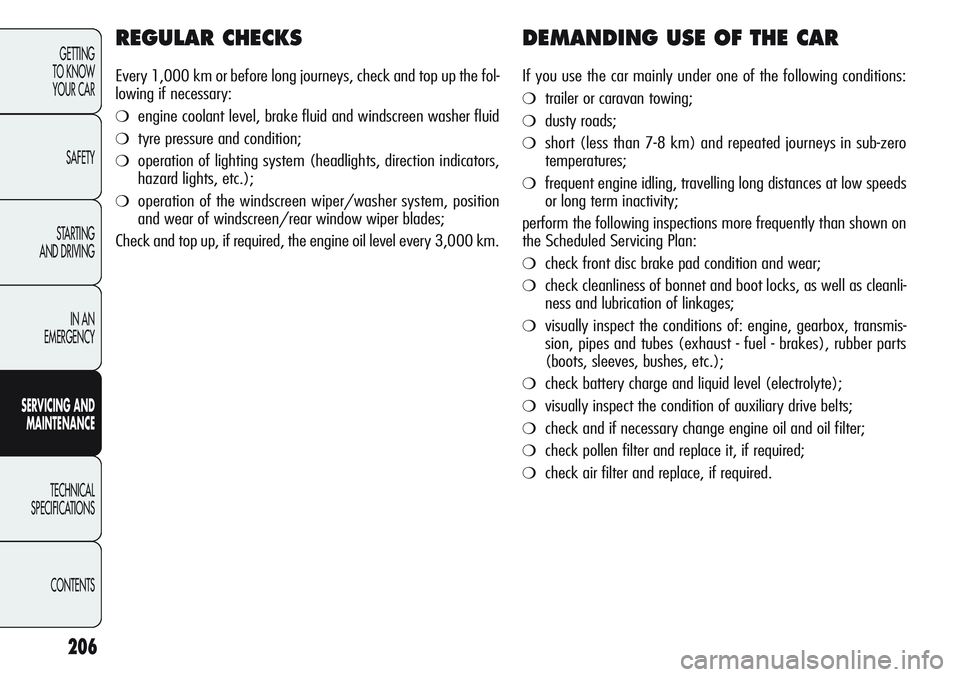
206
GETTING
TO KNOW
YOUR CAR
SAFETY
STARTING
AND DRIVING
IN AN
EMERGENCY
SERVICING AND
MAINTENANCE
TECHNICAL
SPECIFICATIONS
CONTENTS
REGULAR CHECKS
Every 1,000 km or before long journeys, check and top up the fol-
lowing if necessary:
❍engine coolant level, brake fluid and windscreen washer fluid
❍tyre pressure and condition;
❍operation of lighting system (headlights, direction indicators,
hazard lights, etc.);
❍operation of the windscreen wiper/washer system, position
and wear of windscreen/rear window wiper blades;
Check and top up, if required, the engine oil level every 3,000 km.
DEMANDING USE OF THE CAR
If you use the car mainly under one of the following conditions:
❍trailer or caravan towing;
❍dusty roads;
❍short (less than 7-8 km) and repeated journeys in sub-zero
temperatures;
❍frequent engine idling, travelling long distances at low speeds
or long term inactivity;
perform the following inspections more frequently than shown on
the Scheduled Servicing Plan:
❍check front disc brake pad condition and wear;
❍check cleanliness of bonnet and boot locks, as well as cleanli-
ness and lubrication of linkages;
❍visually inspect the conditions of: engine, gearbox, transmis-
sion, pipes and tubes (exhaust - fuel - brakes), rubber parts
(boots, sleeves, bushes, etc.);
❍check battery charge and liquid level (electrolyte);
❍visually inspect the condition of auxiliary drive belts;
❍check and if necessary change engine oil and oil filter;
❍check pollen filter and replace it, if required;
❍check air filter and replace, if required.
Page 217 of 297

213
GETTING
TO KNOW
YOUR CAR
SAFETY
STARTING
AND DRIVING
IN AN
EMERGENCY
SERVICING AND
MAINTENANCE
TECHNICAL
SPECIFICATIONS
CONTENTS
BRAKE FLUID
Check that the fluid is at the maximum level. If the level is too
low undo reservoir cap F-fig. 161-162-163-164 and add the flu-
id described in the “Technical Specifications” chapter.
Prevent brake fluid, which is highly corrosive, from
coming into contact with painted parts. Should this
occur, immediately wash with water.
WINDSCREEN/REAR WINDOW/
HEADLIGHT WASHING FLUID
If the level is too low undo reservoir cap D-fig. 161-162-163-
164 and add the fluid described in the “Technical Specifications”
chapter.
IMPORTANT The headlight washer system will not work when
the liquid level is low although the windscreen/rear window wash-
er will still work. For versions/markets where provided (see pre-
vious pages), a reference line E-fig. 161, 162, 163, 164 is pro-
vided: ONLY the windscreen/rear window washer will work un-
der this line.
Some commercial windscreen washer additives are
flammable. The engine compartment contains hot
parts which could cause a fire if they come into con-
tact with these additives.
Brake fluid is poisonous and highly corrosive. In
the event of accidental contact, wash the parts im-
mediately with water and neutral soap, then rinse
with plenty of water. In case of swallowing, immediately
call a doctor.
The symbol πon the container indicates a syn-
thetic brake fluid, which is different from a min-
eral fluid. Using a mineral-type fluid will damage
the special rubber seals of the braking system beyond re-
pair.
Do not travel if the windscreen washer reservoir is
empty: using the windscreen washer is essential
for improving visibility. Repeated operation of the
system when it is empty could damage or rapidly deteri-
orate some of its parts
Page 224 of 297

220
GETTING
TO KNOW
YOUR CAR
SAFETY
STARTING
AND DRIVING
IN AN
EMERGENCY
SERVICING AND
MAINTENANCE
TECHNICAL
SPECIFICATIONS
CONTENTS
Rear window washer fig. 169
The nozzle holder is located above the rear window. The rear win-
dow washer jets are fixed.
HEADLAMP WASHERS fig. 170
(on request for versions/markets, where provided)
These are located within the front bumper. They are activated when
the dipped beam and/or main beam headlights are on and the
windscreen washer is activated.
Check the condition and cleanliness of nozzles at regular intervals.
fig. 169A0K0102mfig. 170A0K0138m
Page 226 of 297
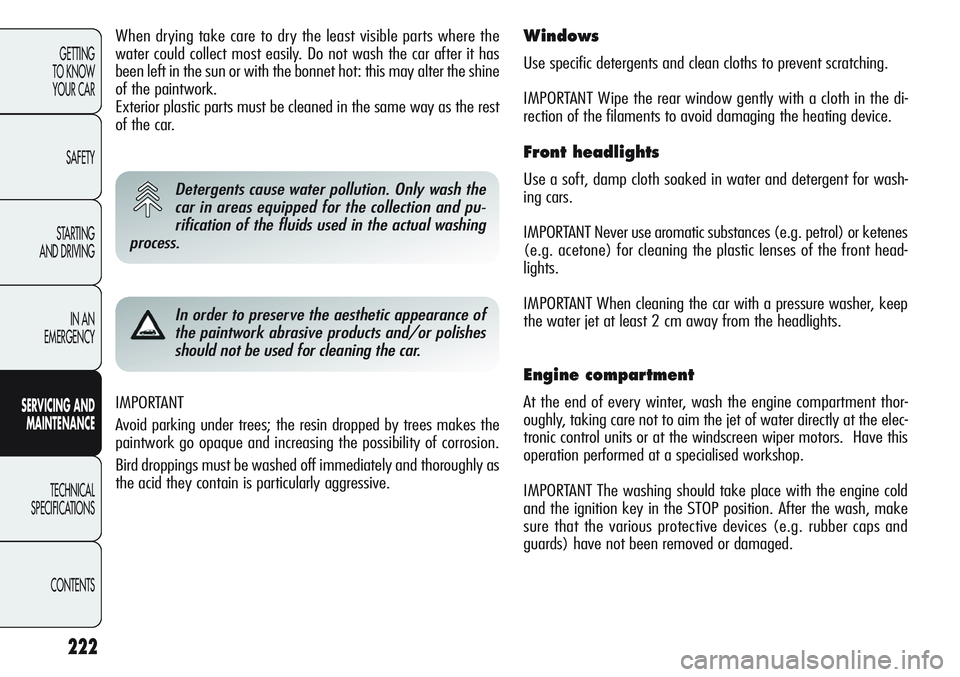
222
GETTING
TO KNOW
YOUR CAR
SAFETY
STARTING
AND DRIVING
IN AN
EMERGENCY
SERVICING AND
MAINTENANCE
TECHNICAL
SPECIFICATIONS
CONTENTS
IMPORTANT
Avoid parking under trees; the resin dropped by trees makes the
paintwork go opaque and increasing the possibility of corrosion.
Bird droppings must be washed off immediately and thoroughly as
the acid they contain is particularly aggressive.
Windows
Use specific detergents and clean cloths to prevent scratching.
IMPORTANT Wipe the rear window gently with a cloth in the di-
rection of the filaments to avoid damaging the heating device.
Front headlights
Use a soft, damp cloth soaked in water and detergent for wash-
ing cars.
IMPORTANT Never use aromatic substances (e.g. petrol) or ketenes
(e.g. acetone) for cleaning the plastic lenses of the front head-
lights.
IMPORTANT When cleaning the car with a pressure washer, keep
the water jet at least 2 cm away from the headlights.
Engine compartment
At the end of every winter, wash the engine compartment thor-
oughly, taking care not to aim the jet of water directly at the elec-
tronic control units or at the windscreen wiper motors. Have this
operation performed at a specialised workshop.
IMPORTANT The washing should take place with the engine cold
and the ignition key in the STOP position. After the wash, make
sure that the various protective devices (e.g. rubber caps and
guards) have not been removed or damaged.
Detergents cause water pollution. Only wash the
car in areas equipped for the collection and pu-
rification of the fluids used in the actual washing
process.
When drying take care to dry the least visible parts where the
water could collect most easily. Do not wash the car after it has
been left in the sun or with the bonnet hot: this may alter the shine
of the paintwork.
Exterior plastic parts must be cleaned in the same way as the rest
of the car.
In order to preserve the aesthetic appearance of
the paintwork abrasive products and/or polishes
should not be used for cleaning the car.
Page 244 of 297
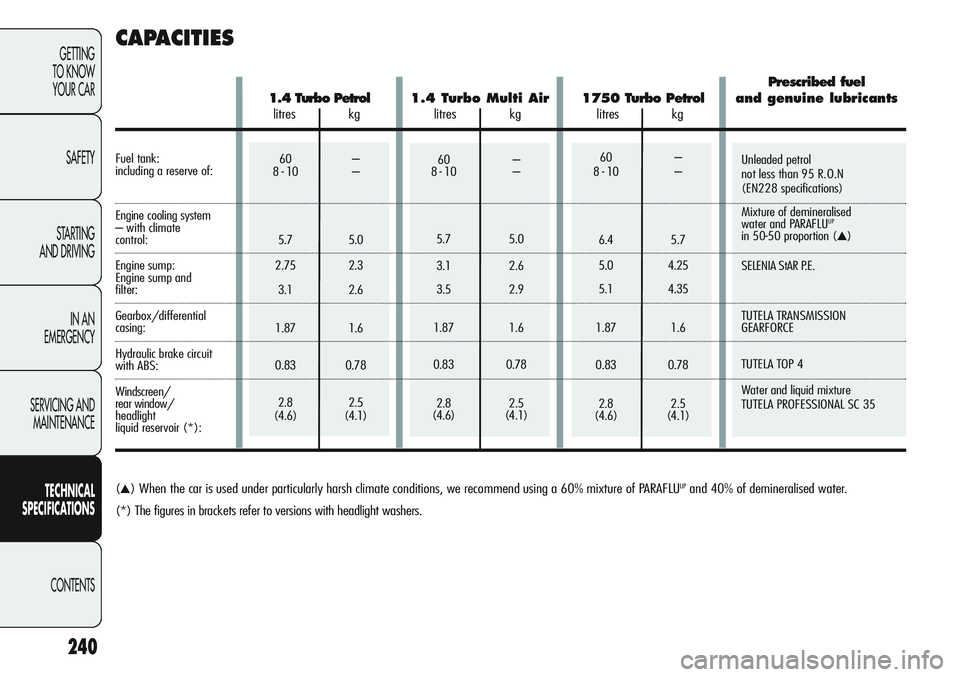
60 –
8 - 10 –
6.4 5.7
5.0 4.25
5.1 4.35
1.87 1.6
0.83 0.78
2.8 2.5
(4.6) (4.1)60 –
8 - 10 –
5.7 5.0
2.75 2.3
3.1 2.6
1.87 1.6
0.83 0.78
2.8 2.5
(4.6) (4.1)60 –
8 - 10 –
5.7 5.0
3.1 2.6
3.5 2.9
1.87 1.6
0.83 0.78
2.8 2.5
(4.6) (4.1)Unleaded petrol
not less than 95 R.O.N
(EN228 specifications)
Mixture of demineralised
water and PARAFLU
UP
in 50-50 proportion (▲)
SELENIA StAR P.E.
TUTELA TRANSMISSION
GEARFORCE
TUTELA TOP 4
Water and liquid mixture
TUTELA PROFESSIONAL SC 35
240
GETTING
TO KNOW
YOUR CAR
SAFETY
STARTING
AND DRIVING
IN AN
EMERGENCY
SERVICING AND
MAINTENANCE
TECHNICAL
SPECIFICATIONS
CONTENTS
CAPACITIES
(▲) When the car is used under particularly harsh climate conditions, we recommend using a 60% mixture of PARAFLUUPand 40% of demineralised water.
(*) The figures in brackets refer to versions with headlight washers.
Prescribed fuel
1.4 Turbo Petrol1.4 Turbo Multi Air1750 Turbo Petrol and genuine lubricants
litres kg litres kg litres kg
Fuel tank:
including a reserve of:
Engine cooling system
– with climate
control:
Engine sump:
Engine sump and
filter:
Gearbox/differential
casing:
Hydraulic brake circuit
with ABS:
Windscreen/
rear window/
headlight
liquid reservoir (*):
Page 245 of 297

Automotive diesel
(EN590 specifications)
Mixture of demineralised
water and PARAFLU
UPin
50-50 proportion (▲)
SELENIA WR P.E.
TUTELA TRANSMISSION
GEARFORCE
TUTELA TOP 4
Water and liquid mixture
TUTELA PROFESSIONAL SC 35
60 –
8 - 10 –
6.8 6.0
4.0 3.4
4.2 3.5
1.87 1.6
0.83 0.78
2.8 2.5
(4.6) (4.1)60 –
8 - 10 –
6.7 5.9
4.0 3.4
4.2 3.5
1.87 1.6
0.83 0.78
2.8 2.5
(4.6) (4.1)
241
GETTING
TO KNOW
YOUR CAR
SAFETY
STARTING
AND DRIVING
IN AN
EMERGENCY
SERVICING AND
MAINTENANCE
TECHNICAL
SPECIFICATIONS
CONTENTS
(▲) When the car is used under particularly harsh climate conditions, we recommend using a 60% mixture of PARAFLUUPand 40% of demineralised water.
(*) The figures in brackets refer to versions with headlight washers.
Prescribed fuel
1.6 JTDM2.0 JTDMand genuine lubricants litres kg litres kg
Fuel tank:including a reserve of:
Engine cooling system
- with climate
control:
Engine sump:
Engine sump and
filter:
Gearbox/differential
casing:
Hydraulic brake circuit with ABS:
Windscreen/rear window/
headlight liquid reservoir (*):
Page 285 of 297

DASHBOARD
1. Fixed vent for sending air to side windows - 2. Adjustable air vent - 3. Passenger front air bag - 4. Upper adjustable vents - 5. Hazard warning
lights - 6. Radio navigator display (for versions/markets, where provided) - 7. External light control stalk - 8. Instrument panel - 9. Windscreen
wiper/rear window wiper/trip computer stalk - 10. Headlight alignment corrector (for versions/markets, where provided) and Set Up Menu
access buttons - 11. Ignition device - 12. Driver's front air bag - 13. Cruise Control stalk (for versions/markets, where provided) - 14. Control
buttons: fog lights/rear fog light, Start&Stop system (for versions/markets, where provided), door locking/unlocking, AFS light on/off (for
versions/markets, where provided) - 15. “Alfa DNA” system - 16. Gear lever - 17. Heating/ventilation/air conditioning controls - 18. Sound sys-
tem (for versions/markets, where provided) - 19. Central adjustable air vents - 20. Glove compartment.
A0K0225m
19.522.0cACAAUT O
MONOC
123
4
56
4789
21
20
19
1817
16
1514
1312
1110
281
RIGHT-HAND DRIVE VERSIONS
Page 290 of 297
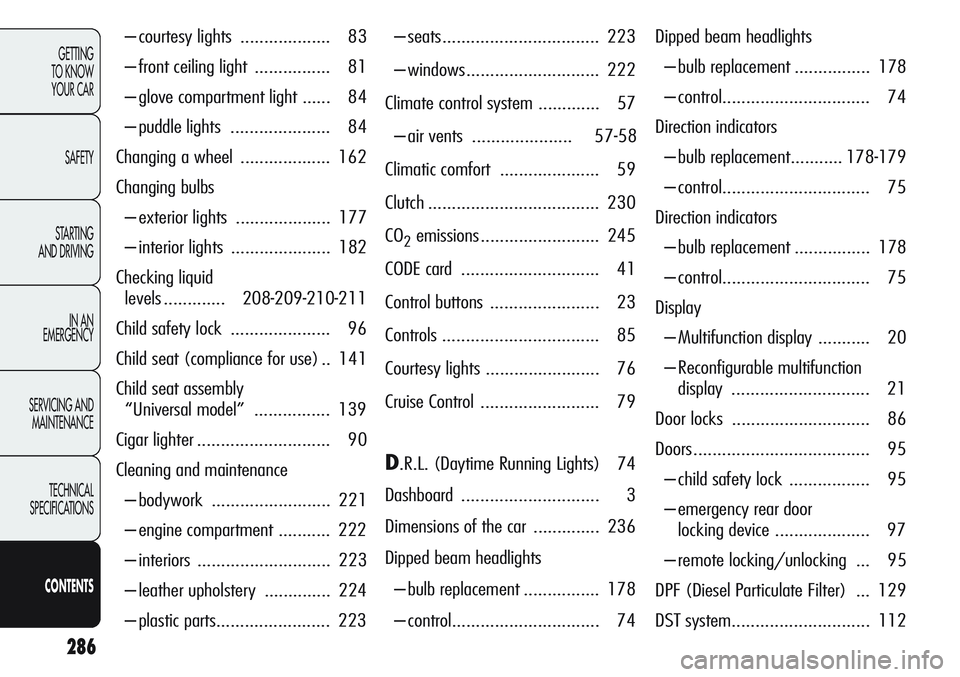
286
GETTING
TO KNOW
YOUR CAR
SAFETY
STARTING
AND DRIVING
IN AN
EMERGENCY
SERVICING AND
MAINTENANCE
TECHNICAL
SPECIFICATIONS
CONTENTS
– courtesy lights ................... 83
– front ceiling light ................ 81
– glove compartment light ...... 84
– puddle lights ..................... 84
Changing a wheel ................... 162
Changing bulbs
– exterior lights .................... 177
– interior lights ..................... 182
Checking liquid
levels .............208-209-210-211
Child safety lock ..................... 96
Child seat (compliance for use) .. 141
Child seat assembly
“Universal model” ................ 139
Cigar lighter............................ 90
Cleaning and maintenance
– bodywork ......................... 221
– engine compartment ........... 222
– interiors ............................ 223
– leather upholstery .............. 224
– plastic parts........................ 223– seats................................. 223
– windows............................ 222
Climate control system ............. 57
– air vents .....................57-58
Climatic comfort ..................... 59
Clutch .................................... 230
CO
2emissions ......................... 245
CODE card ............................. 41
Control buttons ....................... 23
Controls................................. 85
Courtesy lights ........................ 76
Cruise Control ......................... 79
D.R.L. (Daytime Running Lights) 74
Dashboard............................. 3
Dimensions of the car .............. 236
Dipped beam headlights
– bulb replacement ................ 178
– control............................... 74Dipped beam headlights
– bulb replacement ................ 178
– control............................... 74
Direction indicators
– bulb replacement........... 178-179
– control............................... 75
Direction indicators
– bulb replacement ................ 178
– control............................... 75
Display
– Multifunction display ........... 20
– Reconfigurable multifunction
display ............................. 21
Door locks ............................. 86
Doors..................................... 95
– child safety lock ................. 95
– emergency rear door
locking device .................... 97
– remote locking/unlocking ... 95
DPF (Diesel Particulate Filter) ... 129
DST system............................. 112
Page 291 of 297

287
GETTING
TO KNOW
YOUR CAR
SAFETY
STARTING
AND DRIVING
IN AN
EMERGENCY
SERVICING AND
MAINTENANCE
TECHNICAL
SPECIFICATIONS
CONTENTS
Electric sunroof ...................... 92
Electric windows ..................... 98
Electromechanical power
assisted steering................... 121
Electronic Q2 (“E-Q2”) ............ 112
Engine
– identification codes .............. 227
– marking ............................ 226
– technical specifications .. 228-229
Engine codes .......................... 227
Engine compartment
– checking fluid levels ............ 207
– opening/closing the bonnet .. 107
– washing ........................... 222
Engine oil
– consumption ..................... 212
– level check ........................ 208
– specifications ..................... 242
Environment (protecting) ......... 129
EOBD system .......................... 121
External lights ........................ 74Fire extinguisher ..................... 91
Fix&Go Automatic device .......... 169
Fluids and lubricants
(specifications)...............242-243
Fog lights
– bulb replacement ................ 178
– control............................... 85
“Follow me home” device......... 76
Front ceiling lights ............. 81-82
– bulb replacement ................ 182
Fuel
– fuel cut-off system .............. 86
– how to save fuel ................ 155
Fuel cap ................................ 128
Fuel reserve ......................240-241
Fuel supply............................. 230
Fuse replacement .................... 186
Fuseboxes (location).. 188-189-190
Fuses
– fuseboxes ........... 188-189-190– list of fuses ......... 191-192-193
– replacement ....................... 186
Gearbox use.......................... 154
Getting to know your car.. 3
Glove compartment light
– bulb replacement ................ 184
GSI (Gear Shift Indicator) ......... 22
Hazard warning lights ............. 85
Head restraint.................... 53-54
– “Anti Whiplash” device ....... 53
Headlight alignment corrector ... 108
Headlight washers
– checking liquid
level ..........208-209-210-211
– control............................... 220
Headlights
– alignment corrector ............. 109
– bulb replacement ................ 177
Page 292 of 297
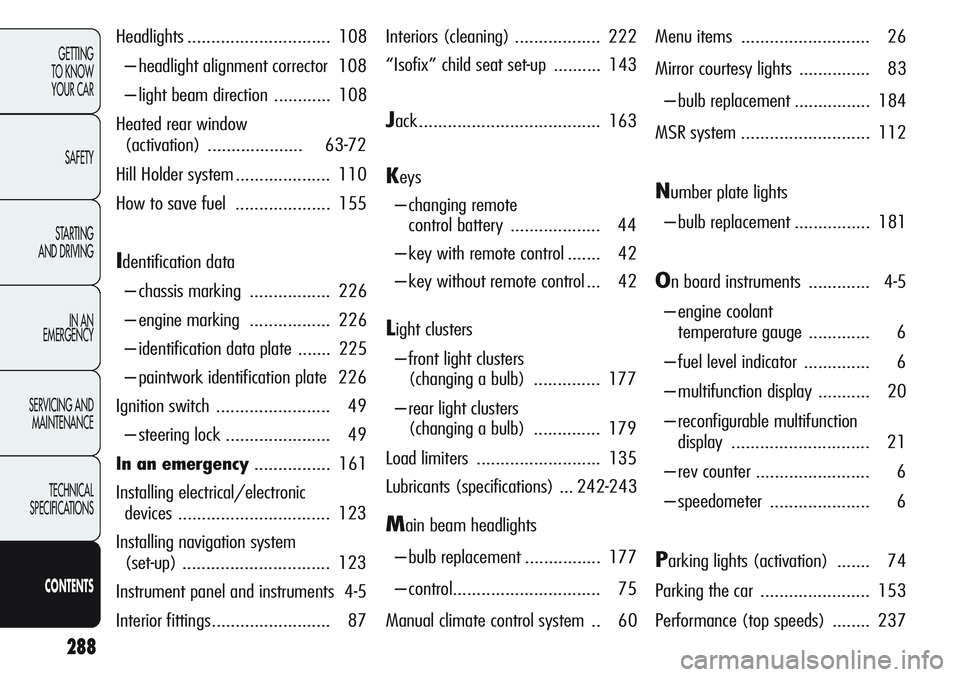
288
GETTING
TO KNOW
YOUR CAR
SAFETY
STARTING
AND DRIVING
IN AN
EMERGENCY
SERVICING AND
MAINTENANCE
TECHNICAL
SPECIFICATIONS
CONTENTS
Headlights.............................. 108
– headlight alignment corrector 108
– light beam direction ............ 108
Heated rear window
(activation) .................... 63-72
Hill Holder system .................... 110
How to save fuel .................... 155
Identification data
– chassis marking ................. 226
– engine marking ................. 226
– identification data plate ....... 225
– paintwork identification plate 226
Ignition switch ........................ 49
– steering lock ...................... 49
In an emergency................ 161
Installing electrical/electronic
devices ................................ 123
Installing navigation system
(set-up)............................... 123
Instrument panel and instruments 4-5
Interior fittings......................... 87Interiors (cleaning) .................. 222
“Isofix” child seat set-up .......... 143
Jack...................................... 163
Keys
– changing remote
control battery ................... 44
– key with remote control ....... 42
– key without remote control ... 42
Light clusters
– front light clusters
(changing a bulb).............. 177
– rear light clusters
(changing a bulb).............. 179
Load limiters .......................... 135
Lubricants (specifications) ... 242-243
Main beam headlights
– bulb replacement ................ 177
– control............................... 75
Manual climate control system .. 60Menu items ........................... 26
Mirror courtesy lights ............... 83
– bulb replacement ................ 184
MSR system........................... 112
Number plate lights
– bulb replacement ................ 181
On board instruments ............. 4-5
– engine coolant
temperature gauge ............. 6
– fuel level indicator .............. 6
– multifunction display ........... 20
– reconfigurable multifunction
display ............................. 21
– rev counter ........................ 6
– speedometer ..................... 6
Parking lights (activation) ....... 74
Parking the car ....................... 153
Performance (top speeds) ........ 237